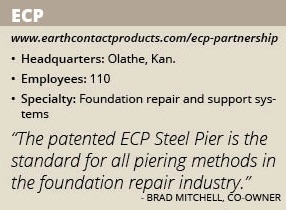ECP: Pioneering Quality in Foundation Repair Solutions
Stronger Than All
Patented steel piers and strong partnerships demonstrate ECP’s quality.
When time is of the essence, Earth Contact Products (ECP) says clients can count on it to provide the highest-quality products and support. This simple idea has been ECP’s commitment since it was established in 1998, and it continues to hold true now that it has become one of the largest manufacturers of helical anchors, steel piers and waterproofing products in the world. ECP is the leader in pursuing innovation, and ECP’s steel push piers are a strong example of its dedication to excellence. From its family of foundation underpinning products to its concentric and eccentric steel resistance piers, ECP takes pride in providing products that are designed and engineered to perform.
“The ECP Steel Pier belongs to a family of patented foundation repair products that also are referred to as micro piles, push piers or resistance piers,” CEO Brad Mitchell says. “The patented ECP Steel Pier is the standard for all piering methods in the foundation repair industry and the top choice for professional foundation repair contractors, it’s that simple. Once a foundation repair contractor uses our piers they never leave because they can instantly see the difference in American-made quality products vs. foreign. Everything we do is made in America and that is something that we are very proud of.”
Safe and Stable
ECP is ICC certified and provides an industry-leading 25-year product warranty. The company offers two basic engineered designs of its patented push pier: the concentric pier installs directly below the footing (or load), and the eccentric pier installs to the side of the intended load. Usually it’s the application that determines which model of steel pier is used; both styles of ECP’s piers have been subject to a large amount of engineering and field tests.
The company explains ECP Steel Piers are end-bearing piers that do not rely upon skin friction to produce support, unlike concrete cylinders. Each pier is field-load tested after it is installed, and the push piers can be relied on as safe because they are installed and load tested individually, using the maximum weight of the structure as the reaction force. The system develops a significant safety factor because of the different foundation lifting methods used between pier installation and load transfer during restoration.
ECP Steel Piers are driven individually and the entire structure works as the reaction. A friction-reduction collar is attached to the lead section of the galvanized pier pipe. The collar creates an opening in the soil with a larger diameter than the pier pipe, which reduces the skin friction on the pier pipe as it is driven into the soil. It allows the installer to test and verify that the pier encountered firm bearing stratum or rock suitable to support the design load.
During load transfer or lift, high-pressure hydraulic jacks are placed at multiple locations, which reduces the load on each resistance pier to only the design working load. The hydraulic jacks are connected to the ECP Manifold System to provide a synchronized lift or stabilization of the structure. A building with substantial construction and rigidity can develop greater pier factor safety than lighter or weaker structures. An ECP foundation repair contractor or registered foundation engineer can help clients evaluate and solve foundation issues.
“The patented ECP PPB-300 and the ECP-PPB-350 steel piers are the standard in steel underpinning,” Mitchell says. “Our design and engineering allows you to use ECP push pier technology to structurally underpin foundations down to a true load bearing stratum. The steel pier design penetrates the soil deeply beyond the active expansive clay soils to support structures from either the interior or exterior of the structure. ECP, the leader in steel pier technology, is known for the strongest and deepest driving pier systems available.”
The company also offers its Helical Pier System, which permanently stabilizes a home’s foundation and is manufactured and engineered to perform. Using small construction equipment, the ECP helical piers are mechanically “drilled” through the shifting soil to a stable, load-bearing strata. After the installation has reached the specified depth and verified capacity, a steel foundation bracket is connected to the ECP helical pier and the home’s foundation.
Building Partnerships
Just as ECP takes pride in the quality of its products and systems, the company is looking for high-quality partners. ECP Partners are provided with on-site training and backup from the ECP engineering team. The company offers product documentation and is happy to support partners in their work, creating a tight network. ECP also makes 3-D models in-house, which it provides to its partners to use.
ECP is looking for additional contractors in areas such as Salt Lake City; Seattle and Tacoma, Wash.; Portland, Salem and Eugene, Ore.; Santa Fe and Albuquerque, N.M.; Wichita, Kan.; Minneapolis and St. Paul, Minn.; Springfield and Peoria, Ill.; Columbus, Ohio; Columbia and Charleston, S.C.; Raleigh and Durham, N.C.; Philadelphia; and Trenton, N.J.
“We look at our contractors as more than installers,” Mitchell says. “Our partners are the main reason we are where we are today in the industry. From coast to coast we wouldn’t be where we are without them. We want to provide each of our partners the backup and training to make them all successful. ECP is always there for our network of partners with the best quality products and training so each job is done right the first time and their customers have peace of mind they are doing the project with the best.”